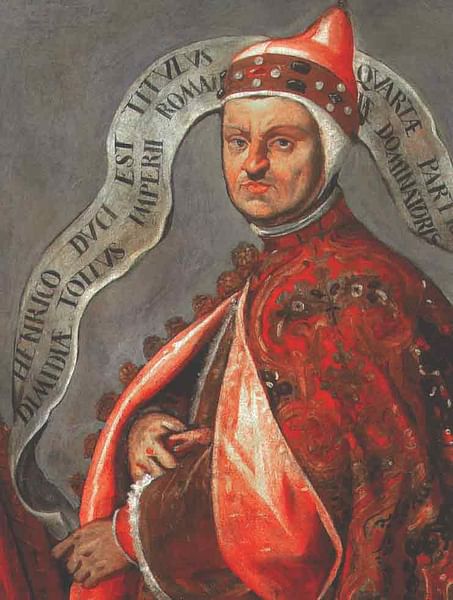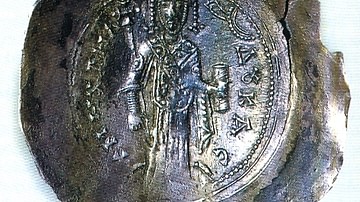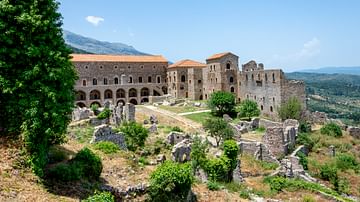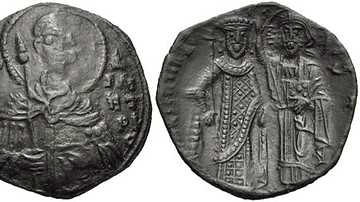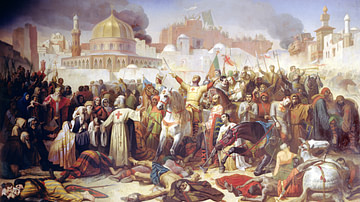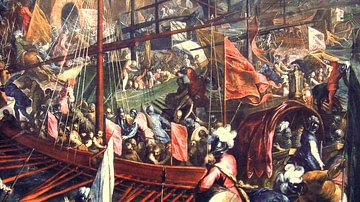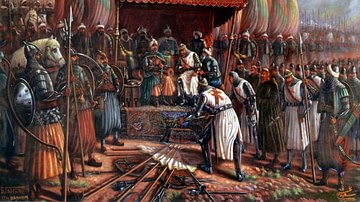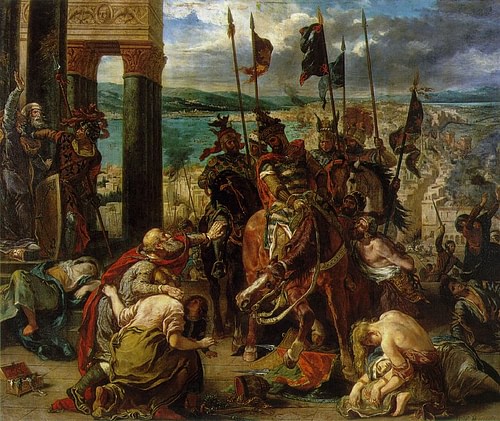
The Fourth Crusade (1202-1204 CE) was called by Pope Innocent III (r. 1198-1216 CE) to retake Jerusalem from its current Muslim overlords. However, in a bizarre combination of cock-ups, financial constraints, and Venetian trading ambitions, the target ended up being Constantinople, capital of the Byzantine Empire and the greatest Christian city in the world. Sacked on 12 April 1204 CE, Constantinople was stripped of its riches, relics, and artworks, and the Byzantine Empire was divided up between Venice and its allies. The Fourth Crusade thus gained its infamous reputation as the most cynical and profit-seeking of all the crusades.
East-West Suspicion
The Byzantines saw themselves as the defenders of Christendom, the beacon which shone out across the Mediterranean and central Asia, hosts to the holiest city outside Jerusalem, and the rock which stood against the tide of Islam sweeping in from the east. By the western half of the old Roman Empire, though, the Byzantines were regarded as decadent, shifty, and untrustworthy; even their religious practices were suspect. This essential division between the east and west had caused constant problems in all the previous crusades, and it was to crop up again in this one.
There were also more concrete sources of division, the historical rivalry between popes and emperors, and the rising ambition of western states to wrest from Byzantium the remnants of its empire in Italy were fuelled by the failures of the crusades in permanently securing the Holy Land for Christendom. Blame was apportioned to either side for the lack of success. The Byzantines were considered to lack the will to fight the common Muslim enemy while, from the other side, the Crusaders were seen as opportunists out to grab the choicest parts of the Byzantine Empire in the east. In a sense, both sides were right in their judgement.
Venice & the Fourth Crusade
The Third Crusade (1187-1192 CE), although achieving some notable military successes, had failed completely in its original objective of recapturing Jerusalem from the Muslim Sultan of Egypt and Syria, Saladin (r. 1174-1193 CE). The celebrated Sultan was now dead, but the Holy City remained in Muslim hands. Yet another crusade was required. The Fourth Crusade was thus called for by Pope Innocent III (r. 1198-1216 CE) in August 1198 CE. As previously, those who went to the Holy Land and fought the infidels would receive a remission of their sins, but as an added incentive, Innocent III now extended this 'benefit' to those who gave the necessary money to fund a warrior to go in their stead.
The Pope's timing was not the best, especially considering the Holy City had anyway been in Muslim hands since 1187 CE. In the final years of the 12th century CE, all four monarchs of Europe's most powerful kingdoms, England, France, Germany, and Spain, were busy with internal affairs, and in the case of England and France, serious territorial squabbles with each other. Worse still, in April 1199 CE, the great Crusader king Richard I of England (r. 1189-1199 CE), who had promised to return to the Holy Land and finish his undone work during the Third Crusade, died on campaign in France.
Unlike the previous Crusade, then, this was not to be a “Kings' Crusade”. Still, a good number of second-tier nobles were inspired to join up or 'take the cross', as it was known, especially from northern France. There were the counts of Champagne and Blois (although the former would die before the expedition got underway), Geoffrey of Villehardouin (who would later write his Conquest of Constantinople, an important record of the Crusade), Count Baldwin of Flanders, and Simon de Montfort. In August 1201 CE the leader of the expedition, after the untimely death of Theobald of Champagne, was selected. The choice was an immensely rich and chivalrous Italian with an impressive Crusader pedigree in his family, Marquis Boniface of Montferrat. Perhaps significantly, given future events, Boniface also had family connections with the Byzantine Empire, one of his brothers marrying the daughter of Byzantine emperor Manuel I (r. 1143-1180 CE) and another brother marrying the sister of the deposed Byzantine emperor Isaac II Angelos (r. 1185-1195 CE).
In October 1202 CE the army was finally ready to set sail from Venice to Egypt - seen as the soft underbelly of the enemy - or at least, that was the original plan. The Venetians, being the rapacious traders they were, insisted that their 240 ships be paid for, but the Crusaders could not meet the astonishing asking price of 85,000 silver marks (double the annual income of France at the time). Consequently, a deal was made that in return for passage the Crusaders would stop off at Zara on the Dalmatian coast and reconquer it for the Italians, the city having recently defected to the Hungarians. The Venetians would also provide 50 warships for the Crusade at their own cost and receive half of any territory conquered.
The Pope was not best pleased to hear the news that Christian Zara had been sacked on 24 November 1202 CE, and he promptly excommunicated the Crusaders and the Venetians. The ban was later lifted for the former, otherwise, they would not have been much use as Crusaders, one supposes. It is also true that many of the Crusader leaders, notably Simon of Montfort, had actually refused to attack Christian Zara and a significant number of men had even left the Crusade over the issue.
Objective Constantinople
Historians continue to debate the exact reason why the Crusaders then turned on Constantinople instead of Jerusalem, but one crucial ingredient in the troublesome mix of mutual suspicions between the western powers and Byzantium was the Republic of Venice and one man, in particular, the Doge Enrico Dandolo (r. 1192-1205 CE). Intent on winning Venetian domination of the trade in the east, Dandolo well remembered his undignified expulsion from Constantinople when he had served there as an ambassador. This seemed as good an opportunity as ever to install a new sympathetic emperor. Alexios IV Angelos (r. 1203-1204 CE), whose father Isaac II Angelos had been deposed as emperor seven years earlier, had been touting for western support for some time. This would permit Venice to get several steps ahead of long-time trade rivals Pisa and Genoa in cornering the trade market within the Byzantine Empire. It may, then, have been the goal of Dandolo and the Crusaders to merely pass through Constantinople, put a new emperor on the throne and then carry on to Jerusalem with their ships resupplied and their coffers refilled. Given the recent history of rebellions and takeovers in Byzantium, this was perhaps a rather simplified view of possible events. Certainly, things turned out to be a whole lot more difficult for everyone involved.
In addition to material gains for Venice, another possible motivation for targeting Constantinople is that the Pope might achieve the supremacy of the western Church once and for all over the eastern Church. Meanwhile, the Crusader knights would not only gain revenge on the duplicitous Byzantines for their unhelpful support of previous Crusades but also surely pick up some glory and handsome booty in the process. It may not, as some conspiracy-theory historians have claimed, have all been so cynically planned beforehand by all parties, but in the end, it is exactly what happened with the exception that the Fourth Crusade ended with the fall of the Byzantine capital and Jerusalem was left for a later date.
The Sack of Constantinople
The Crusader army arrived outside Constantinople on 24 June 1203 CE. The force consisted of around 4,500 knights and their squires, up to 14,000 infantry, and 20,000-30,000 Venetians. The first target was the Byzantine garrison at nearby Galata on the other shore of the Golden Horn. Thus, the massive chain which blocked the harbour of the Golden Horn could be lowered and the Crusader fleet could directly attack Constantinople's sea walls if required. At the same time, siege engines were built in readiness to attack the city's formidable fortifications on the land side, the Theodosian Walls. The incumbent emperor Alexios III Angelos (r. 1195-1203 CE), caught completely unprepared by the arrival of the Crusaders, fled the city on 17 July 1203 CE.
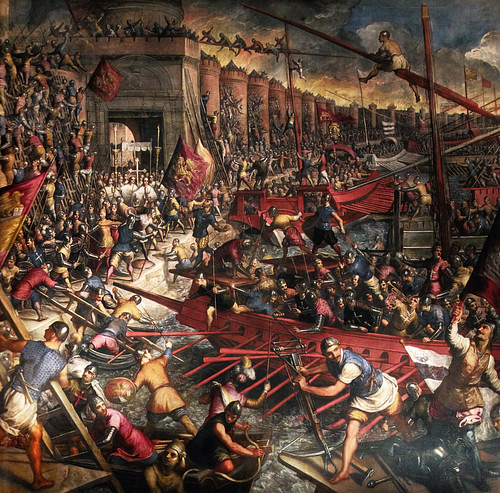
The Crusaders first move was an attempt to put their own supporter on the throne, Alexios IV Angelos along with his father, the former emperor Isaac II Angelos. It was now, though, that the westerners realised that Alexios' promises had all been false. The pair were deeply unpopular with the Byzantines, largely thanks to sustained propaganda against them by their successor, the departed Alexios III, and the obvious threatening presence of the Crusader army camped outside the capital. Consequently, with the throne now effectively empty and with the support of both the people and the army, a usurper stepped in, one Alexios V Doukas, nicknamed 'Murtzurphlus' for his bushy eyebrows. Doukas promised to defend the city at all costs against the Crusaders and he seized the throne after executing his predecessors, father and son together, in January 1204 CE. Constantinople's walls were strengthened, towers were heightened, and several raids made against the Crusader camps.
The Crusaders, with diplomatic avenues exhausted, their supplies dangerously low, and their ships in need of vital repairs and maintenance, had now little option but to try and take the city. They launched an all-out attack on the morning of 9 April 1204 CE, but the Byzantines repelled it. Then, on 12 April, the Crusaders attacked the weaker sea walls of the harbour and targeted two towers in particular by lashing their ships together and ramming them repeatedly. Initially, the defenders held on, but eventually, the attackers forced their way through on both the sea side and the land side, the attackers smashing through the city's gates. A slaughter of the defenders and the city's some 400,000 inhabitants followed. Citizens were raped and massacred, buildings were torched, and churches desecrated. Doukas fled to Thrace, and three days of looting followed where artworks were destroyed, precious goods were melted down, and religious relics were taken back to Europe.
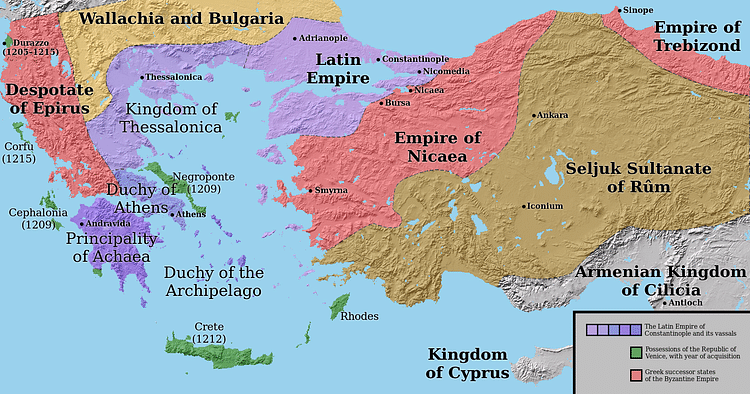
Aftermath
After the looting finally ended, the Partitio Romaniae treaty, already decided on beforehand, carved up the Byzantine Empire amongst Venice and its allies. The Venetians took three-eighths of Constantinople, the Ionian islands, Crete, Euboea, Andros, Naxos, and a few strategic points along the coast of the Sea of Marmara. Thus, Venetian control of Mediterranean trade was now almost total. On 9 May 1204 CE, Count Baldwin of Flanders was made the first Latin Emperor of Constantinople (r. 1204-1205 CE) and crowned in the Hagia Sophia, receiving five-eighths of Constantinople and one-quarter of the Empire which included Thrace, northwest Asia Minor, and several Aegean islands. Boniface of Montferrat took over Thessalonica and formed a new kingdom there, which also included Athens and Macedonia. In 1205 CE, following Baldwin's capture after a battle with the Bulgars defending his territory in Thrace and subsequent death in a Bulgarian prison, William I Champlitte and Geoffrey I Villehardouin (nephew of the historian of the same name) founded a Latin principality in the Peloponnese while the French duke Othon de la Roche grabbed Attica and Boeotia.
The Byzantine Empire would be re-established in 1261 CE, albeit a shadow of its former self, when forces from the Empire of Nicaea, the centre of the Byzantines-in-exile (1208-1261 CE), retook Constantinople. Emperor Michael VIII (r. 1259-1282 CE) was then able to place his throne back in the palace of his Byzantine predecessors.
The Fourth Crusade in the Holy Land
Perhaps understandably, the shocking fall of Constantinople has grabbed almost all the attention of the Fourth Crusade, but there was a small contingent of western Crusaders, led by Renard II of Dampierre, which did fulfil the original purpose of the expedition and reach the Middle East, better late than never, in April 1203 CE. The 300 knights were too few to ever consider attacking well-fortified Jerusalem, or any other important city for that matter, but they did manage to assist the Latin states in perpetuating their precarious existence in the Muslim-dominated Middle East.
In September 1203 CE, in coalition with the now tiny Kingdom of Jerusalem, the Crusaders attacked a few minor targets in Muslim-held Galilee. A plague at Acre then wiped out half of the Crusader force, but as the ruler of Damascus, Al Malik al-'Adil, seemed intent on avoiding a direct confrontation, certain territories were conceded to the Kingdom of Jerusalem including Nazareth, Jaffa, Ramla, and a strip of land near Sidon. Then, in August 1204 CE, the Crusaders twice successfully attacked forces from Hama in central Syria. It was, though, all rather insignificant given the original lofty ambitions of Pope Innocent III. With the Fifth Crusade (1217-1221 CE) concentrating on North Africa and Egypt, it would not be until the Sixth Crusade (1228-1229 CE) that Christian ambitions in the Middle East were revived.
